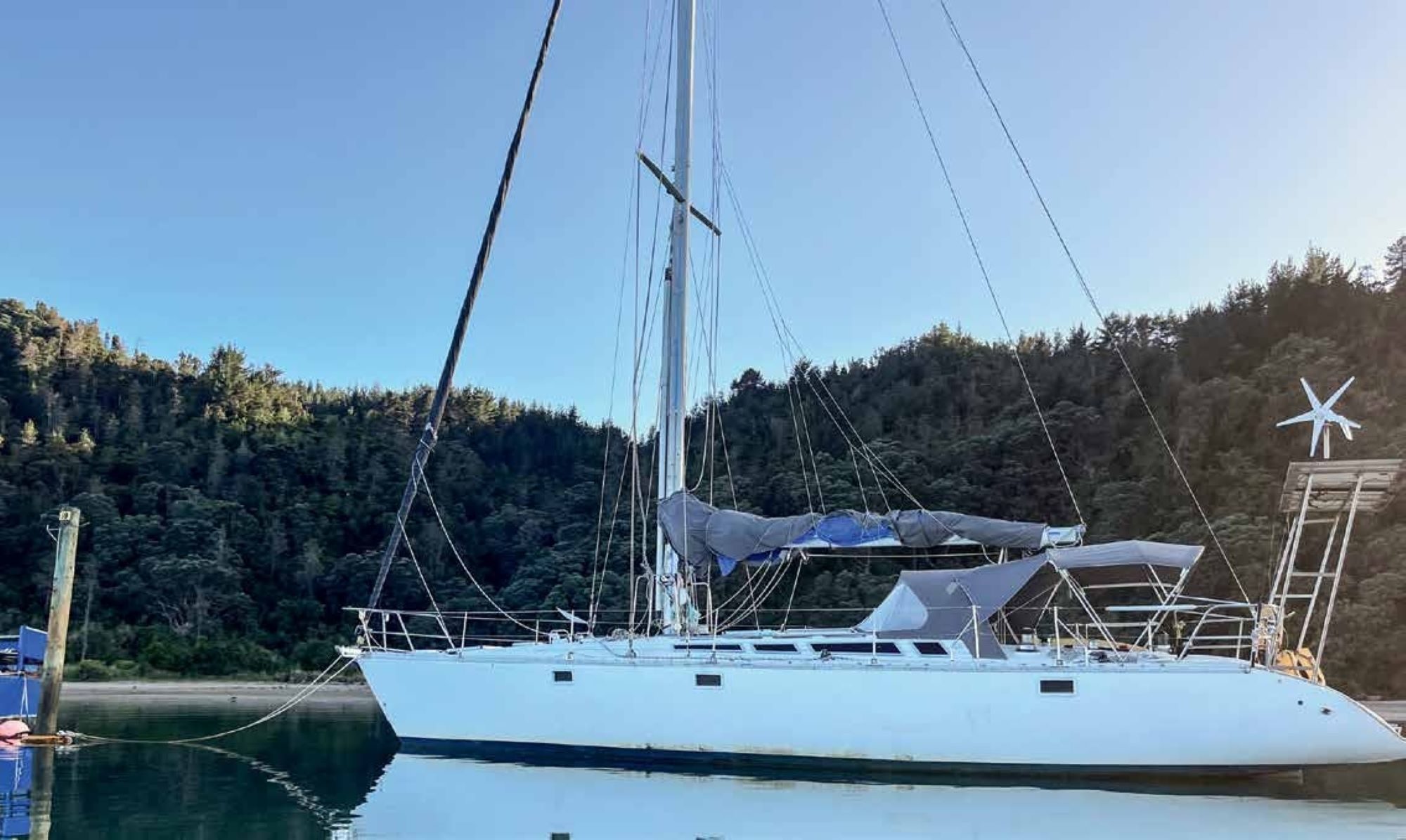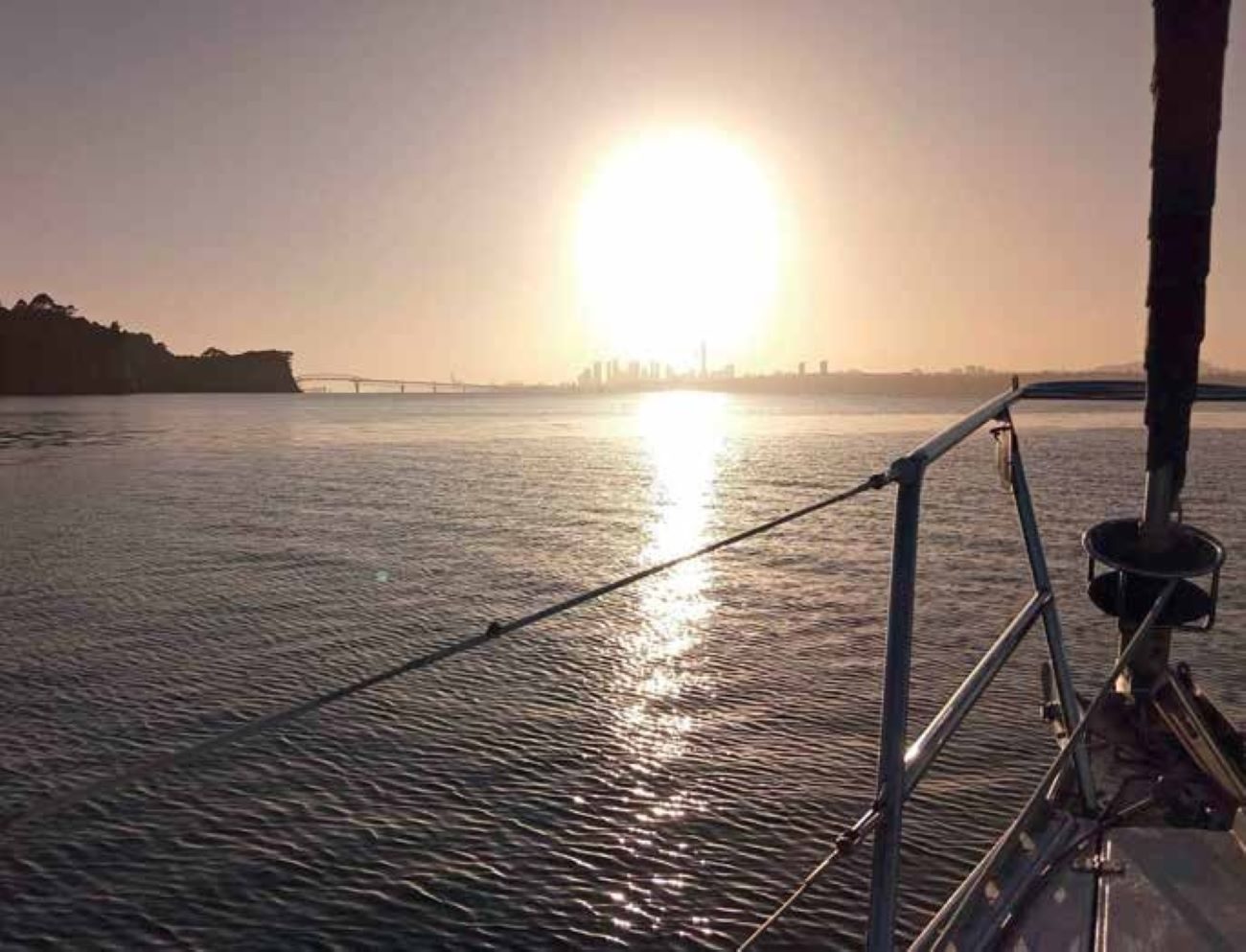

In last month’s article you found me returning to Auckland one day after abandoning a trip out to Sauvage for an afternoon picnic I had planned for my parents. The water proved a little too lively on that day but did allow me views of Sauvage from land. A short glimpse was all I needed to see that Sauvage’s sail cover had come loose from its ropes to flap around in the wind. I returned the following day and was able to secure the sail cover.
To be fair, Sauvage’s current sail cover has seen a few years and is getting towards the end of its life. Many sailing yachts use the sailing cover system for protecting their sails, and it has proved effective. Our sail cover is simply a length of canvas shaped at one end to account for the bulk of the unfurled sail. You place it over the unfurled sail before securing it with clasps under the boom.
On our first-ever sailing adventure, as we headed back into the marina, we opted to leave the sail cover off our unfurled mainsail. We also chose to leave it untethered – a mistake, we now realise (we never did this again!). I was nervous about reentering the marina, which took all my attention. Along came a gust of wind and the sail lifted a little – just a little, but enough to unnerve me. We now secure the sail once it is lowered but this is sometimes not the best approach.
Our cover is ripping and tearing; more importantly the clasps which hold it securely in place under the boom and behind the mast have started to fall off. We now have about half of the clasps required to secure the sail cover. We have been winding a long rope around and around the covered sail to keep the cover in place. It works, but is not ideal, and the kids get niggly with each other, as they have to cooperate to get the cover on and then secure it.


For a while now we’ve considered upgrading our sail cover. We could, in all fairness, replace it with a similar design. It’s simple and uncomplicated. But it doesn’t offer the same advantages as the alternative, which is a sail bag (also known as a ‘stack pack’) – a ‘bag’ secured to the boom with Velcro loops, into which the mainsail is lowered and then the bag is zipped up to fully house the sail. There is no need to tie the bag.
Why a change in direction? I’ve been intrigued that most of the sailing fraternity I follow on YouTube (La Vagabonda, Millennial Falcon and Zatara to name a few) use a sail bag. It just seems cleaner and less effort to me. Once the mainsail is lowered, a sail bag will keep it from collapsing and flopping down over the deck. Currently we don’t put the sail cover on the sail while we’re sailing unless the wind dictates that we should. It would be handy on a longer multi-day sail – and we don’t want to be wrestling with sail ties and grappling with cover clasps, particularly in the dark, in the cold, or in rough seas. Here, the sail remains until conditions are right for zipping up the bag.
On balance, we’ve decided a sail bag is best for us. Now the design begins, and lucky for us, there are quite a few patterns on the Internet. I had the opportunity to head back out to Sauvage last weekend, when the weather was amazingly beautiful, to take measurements. The boom on Sauvage is 5.4 metres long, the bag will have to accommodate this length.
There are two options for the top of the bag: either it is designed so it is the same height at both ends, or else angled from the mast end down to the boom end, which is significantly shallower than the mast end. Most designs I’ve seen are the angled version.
If we choose the angled version, we will start at a measurement of 85cm beside the mast (just enough to encase the sail hardware on the mast), reducing to 20cm at the other end of the boom (these measurements securely fit the sail and fittings at both ends). My initial thoughts are that the angled design seems like a significant engineering effort, and with lowering the sail and the fall that it has, it could, in reality, complicate life. In saying this, there appear to be significantly more sail bags of the angled type around than bags at the same level.
Before writing this month’s article, I had decided a straight top was what we needed. It just seemed easier. But as I write this article, doing more research and looking at what other yachts have, I find I’m debating with myself and again leaning towards an angled design.


The bag will be held aloft by the existing Lazy Jack lines and will come across at 85cm at the mast. For completeness, the part that I missed out of the description here is the return, which goes around the mast, connecting the two sides of the bag that meet the mast. A zip on both sides holds the bag securely around the mast.
Having now measured up, over the next month we will be finding an upholsterer to work with. I would greatly appreciate any feedback our readers have on my chosen design, while accounting for the more height-diverse (ahem, my wife is under five feet tall [152cm]) of our family crew. Please feel free to email through with your comments and feedback (in the near future as I will shortly start cutting with an upholsterer.)
With spring in the air –thank goodness, it is soul uplifting – we’re now planning for the summer. We still have plans for a big sailing adventure, and we keep moving closer to it. In the meantime, we must keep up with BAU maintenance. Sauvage needs to be pulled out for a bottom clean and anti-fouling application. Last time we pulled out was 2021 when the price (over winter) was $400 to be slipped and water blasted, plus $900 a month to sit on the hard. So, you can imagine my shock when I found today’s prices are around $1000 to be pulled out, plus extra for a water blast! It costs well in excess of $100 a day (read about $1000 per week) to sit on the hard while work is done. Ouch.
Today’s price is pretty much reflective of most haulouts in Auckland (I phoned all the marinas that have water deep enough for Sauvage’s 2.6m draft.) As I have said often in my articles, “you only get to spend your money once” and at these prices a haul-out in Auckland seems to be a phenomenal financial undertaking!


So, I continued my search. I found that by taking the boat over to Whitianga I can haul-out for a lot less and sit on the hard for the same price I paid last time. Decision made!
Now our family is patiently sitting and waiting for a suitable school and weather window out of Auckland (and for the absolute pleasure we will have embarking on a voyage again!)
My email is chris@woodhams.nz Please take a moment and drop me your comments on the two questions above. I will share your feedback in the article next month. Until then, safe boating: spring is only weeks away! BNZ




